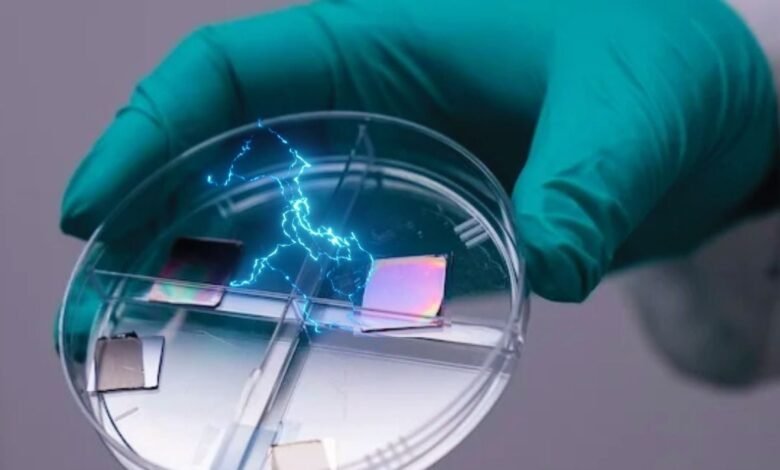US Quantum Leap Solves Renewable Energy’s Biggest Hurdle

▼ Summary
– A breakthrough thermal energy storage system converts heat to electricity at up to 60% efficiency, addressing renewable energy’s intermittency challenge.
– The system uses a thermophotovoltaic converter that emits tailored photons for solar cells, enabling round-the-clock clean power from stored heat.
– Quantum-engineered nanostructured materials create selective light emission to maximize efficiency by matching photovoltaic cells’ sensitive bands.
– This technology could reduce reliance on fossil fuel backups and batteries, improving grid stability and enabling higher renewable energy adoption.
– Future development focuses on scaling up prototypes, enhancing durability, and reducing costs through grid-level pilots and improved components.
A major innovation in the United States is poised to tackle the most significant barrier facing renewable energy, leveraging quantum physics to transform how we store and use power. Early tests reveal a system capable of converting heat into electricity with efficiencies reaching 60%, a figure that could turn energy storage from a persistent challenge into a manageable task. For both individual homes and large electrical grids, the capacity to store thermal energy and dispatch electricity on demand promises to make clean energy sources far more dependable.
This advancement centers on a thermal energy storage unit paired with a thermophotovoltaic converter, a device that transforms stored heat into electricity by emitting carefully controlled light. Rather than relying on conventional battery charging, the system captures surplus heat, stores it efficiently, and then releases photons tailored for solar cells to capture. By separating energy generation from the immediate availability of sun or wind, this method opens the door to continuous renewable power supply.
Intermittency remains the principal obstacle for renewables like wind and solar, which fluctuate with weather patterns and daily cycles. Such unpredictability places stress on electrical grids, often requiring backup from fossil fuel plants or costly battery arrays. A scalable thermal storage solution that efficiently converts heat to electricity directly addresses this issue, helping to balance energy production and stabilize overall demand.
Central to the system’s operation is a high-performance thermal emitter that changes stored heat into finely tuned radiation. While earlier thermophotovoltaic emitters lost energy by emitting a broad spectrum of light, this new design focuses emission within the specific wavelengths where photovoltaic cells operate best. By cutting down on off-band energy losses, developers have achieved net efficiencies near 60% in initial experiments.
The underlying breakthrough stems from nanostructured materials that function as microscopic resonators, shaping the photons released under high temperatures. Arrays of silicon nanocylinders placed on a tungsten base generate collective optical behaviors that favor the creation of high-energy photons. This selective emission marks a real-world success in applying quantum principles to energy systems on a practical scale.
One researcher summarized the potential: “Store heat when the sun shines, turn it into power when it doesn’t, this is how we make renewables truly dispatchable.”
In real-world operation, a thermal energy storage and thermophotovoltaic setup could absorb excess solar energy during midday, retain it as high-temperature heat, and supply electricity after dark. It also offers the ability to capture industrial waste heat, converting otherwise lost thermal energy into usable electricity. Compact and long-lasting modules could serve remote installations, island microgrids, and even space missions.
Reducing reliance on traditional batteries may lessen dependence on scarce minerals and lower the overall environmental footprint. Thermal storage systems often use recyclable materials and can be scaled using well-understood high-temperature components. This approach could ease supply chain constraints and enhance long-term energy resilience.
The quantum-level engineering allows designers to effectively “filter” emitted light so that the majority of photons align with the ideal absorption range of photovoltaic cells. This leads to higher conversion efficiency without pushing operating temperatures beyond safe limits. Improved spectral control also reduces cooling requirements and boosts the economic feasibility of the system.
Widespread adoption of this technology could alter how utility companies handle peak electricity demand, smoothing out the variability of renewables without resorting to fossil-fueled peaker plants. It might also support higher proportions of wind and solar on the grid without compromising reliability. In regions where batteries are expensive or difficult to maintain, this method could expand access to clean power.
Early findings are promising, but the real measure of success will come from scaling the technology and proving its long-term durability. The next stage of development focuses on integrated prototypes, manufacturing readiness, and pilot projects that can operate at the grid level.
Key milestones include the creation of storage materials that can withstand extreme heat over multiple cycles and the validation that nanostructured emitters maintain their spectral precision through continuous heating and cooling.
Engineers must also work to minimize energy losses throughout the entire conversion chain, from heat to light to electricity, when moving from lab settings to commercial-scale systems. Equally crucial is achieving a cost structure competitive with existing storage solutions, ensuring the technology can attract real investment from utilities.
If these hurdles are cleared, the outcome could be profound: light precisely controlled at the quantum level transforming stored heat into dispatchable electricity, stabilizing renewable energy generation, and significantly reducing dependence on fossil fuel backups.
(Source: NewsAPI Tech Headlines)
